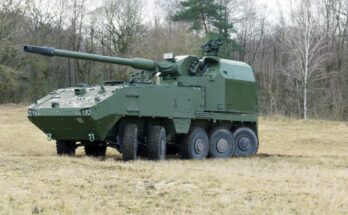Defense Ministers for France and Germany have signed-off on an industrial workshare agreement to develop a future battle tank ground combat system. Formalized on April 26, the agreement will see each nation receive equal parts of industrial work – a major sticking point within other multinational European defense projects past and present.
Under the pact Germany will spearhead the project and begin awarding contracts for the first demonstrator phase by the end of the year.
Both France and Germany are seeking a successor to their respective main battle tanks – the Leclerc with the French Army and the Leopard 2 with the Bundeswehr – by 2040.
The latest step between France and Germany essentially revitalizes a longstanding project referred to as the Main Ground Combat System (MGCS). That prospective initiative was first launched in 2012 but remained stalled due to disagreements between the two partners regarding industrial participation and workshare.
Now, with French Armed Forces Minister Sebastian Lecornu and Germany’s Defense Minister Boris Pistorius working together for over eight months to find a path forward, companies such as Germany’s Rheinmetall, France’s Thales, and the joint Franco-German KNDS (comprised of Germany’s Krauss-Maffei Wegmann (KMW) and France’s Nexter Defense Systems) can begin working on proposals.
The MGCS project was conceived with five phases in mind. The first phase involved an operational needs analysis. The second covered a concept survey. Both initial phases are complete.
The program now enters the third phase – development and technological capability demonstration – under German oversight. It will then progress to the fourth phase involving integration and systems demonstration, before finally advancing to mass system production in the end-phase.
The MGCS “system of systems” would optimally entail a main battle tank accompanied by unmanned ground systems augmented by artificial intelligence (AI).
The Bundeswehr envisions a modular system using a common undercarriage involving multiple specialized tank variants. It also foresees utilization of a hybrid diesel-electric engine to mitigate the noise factor. However, while emerging issues in the tank domain – such as vulnerability to attacks from unmanned aerial systems and the need for more powerful cannons than the traditional 120mm – are on the minds of Bundeswehr planners, the MGCS project remains a drawing board concept.
For his part, Lecornu boasts that the future MGCS will be designed with the future of the tank in mind, rather than the “tank of the future”. He has stated that the tank that eventually rolls off the final assembly line “will look nothing like today’s tanks“.
To get to that point, however, designers must consider the operational experience of tanks over the course of recent military operations ranging from the Second Nagorno-Karabakh conflict to the ongoing Russia-Ukraine war where hundreds and hundreds of tanks have been destroyed.
Factors such as mobility, weight, firepower (with either a 130mm or 140mm cannon and concomitant shell ammunition deemed the most likely solution) and armor all being considered in the future design.
Both France and Germany needed to put industrial workshare disagreements aside and jump-start the cooperative project to achieve their targeted delivery timeline of 2040 at the latest. The ambitious target put pressure on both sides to iron out a political agreement and give the project forward momentum.
That necessary step becomes more obvious when looking at the state of both armies’ current platforms and the possibility that France will need the MGCS delivered before 2040, possibly as soon as 2035. That could, in turn, render asynchronous the timeframe ambitions of the two partners.
With a contract in hand to produce the latest 2A8 variant of its venerable Leopard 2 tank in the coming years, KMW will be providing an interim solution for the Bundeswehr that should buy a bit of time for the MGCS to develop without Germany in immediate need for a replacement.
The French Army, however, will probably need their future tank solution within a faster timeline as production of the Leclerc ceased back in 2008. While 200 French Army Leclerc tanks are being upgraded to the XLR standard under a midlife upgrade contract awarded by the French DGA procurement agency to Nexter on June 24, 2021, these tanks will not be new-build versions like those the Bundeswehr is receiving.
The scale of the project itself – designing a novel system representing a generational leap in technology, testing it, serially producing it, and delivering them into service within 16 years – may well prove more difficult to achieve than outlined on paper.
But for now the all-important political question finally appears to be in the rearview, meaning one of the biggest hurdles facing the project has been cleared.
Dan Darling is Forecast International’s director of military and defense markets. In this role, Dan oversees a team of analysts tasked with covering everything from budgeting to weapons systems to defense electronics and military aerospace. Additionally, for over 17 years Dan has, at various times, authored the International Military Markets reports for Europe, Eurasia, the Middle East and the Asia-Pacific region.
Dan's work has been cited in Defense News, Real Clear Defense, Asian Military Review, Al Jazeera, and Financial Express, among others, and he has also contributed commentary to The Diplomat, The National Interest and World Politics Review. He has been quoted in Arabian Business, the Financial Times, Flight International, The New York Times, Bloomberg and National Defense Magazine.
In addition, Dan has made guest appearances on the online radio show Midrats and on The Media Line, as well as The Red Line Podcast, plus media appearances on France 24 and World Is One News (WION).




